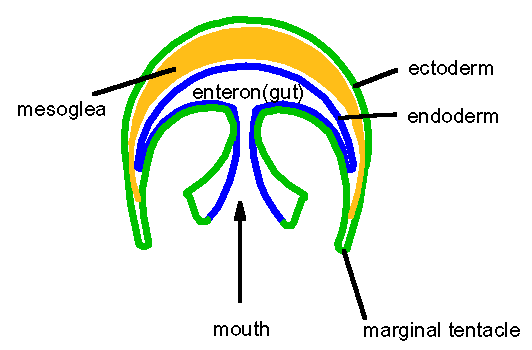How Many Tissue Layers Do Cnidarians Have
They show symbiotic relationships with other marine organisms. Sponges are filter feeders.
Do Cnidarians Have Tissues Or Organs Quora
This glossary of biology terms is a list of definitions of fundamental terms and concepts used in biology the study of life and of living organismsIt is intended as introductory material for novices.

. Anthozoa is a class of marine invertebrates which includes the sea anemones stony corals and soft coralsAdult anthozoans are almost all attached to the seabed while their larvae can disperse as part of the planktonThe basic unit of the adult is the polyp. Sponges belong to the group of invertebrates known as cnidarians. They have a soft simple polyp-style body with two tissue layers.
This consists of a cylindrical column topped by a disc with a central mouth surrounded by tentacles. Most sponges have bilateral symmetry. The distribution of spiracles can vary among the many orders of insects but in general each section of the body can have only one pair of spiracles each of which joins an atrium and has a relatively big tracheal tube behind it.
The mesoglea jelly-like serves as a little more than a glue in some of these members while in a majority of the cnidarian animals as seen in jellyfish it makes for the. They show both sexual and asexual type of reproduction. D Grasshoppers have spicules and tracheal tubes that serve as the means of gas exchange while crayfish have gills.
Sponges can only reproduce asexually by fragmentation or budding. For more specific and technical definitions from sub-disciplines and related fields see Glossary of genetics Glossary of evolutionary biology Glossary of ecology and Glossary of scientific. Sponges are filter feeders.
A coral reef is built up by layers of these skeletons covered by living polyps. Members of this group have only two body layers ectoderm and the endoderm. The ectoderm and the endoderm and a central gut cavity.
How Do Reefs Form. The tracheae are invaginations of the cuticular that is a branch anastomose throughout the body with diameters from only a few micrometers up to. Explanation A sponge obtains microscopic food particles by.
They have a central gastro-vascular cavity with a single opening mouth on hypostome. C Grasshoppers have well-developed nervous systems while crayfish have a ladder network of nerves. Mesoglea is found between these two body layers.
The polyps reproduce either through fragmentation when a piece breaks off and new polyps form or sexual reproduction through spawning. The mouth is enclosed by stinging tentacles. B Grasshoppers have compound eyes while crayfish have a simple eye.
Some of the cnidarians eg corals have a skeleton composed of calcium carbonate. Browse our listings to find jobs in Germany for expats including jobs for English speakers or those in your native language. A Crayfish have an exoskeleton while grasshoppers do not.
Cnidarians exhibit tissue level of organisation and are diploblastic. Sponges have two germ layers which give rise to well-organized tissues. Their body lacks external or internal calcareous skeletons.
Digestion is extracellular and intracellular. Cnidarians do not show bones and a central nervous system rather have a nerve net. As the polyps live reproduce and die they leave their skeletons behind.

Body Plan Of Diploblastic Cnidarian Cnidaria Cycle For Kids Biology Notes

More On Morphology Of Cnidaria

Phylum Cnidaria General Characteristics Sketch Mouth Cnidaria Teaching
Comments
Post a Comment